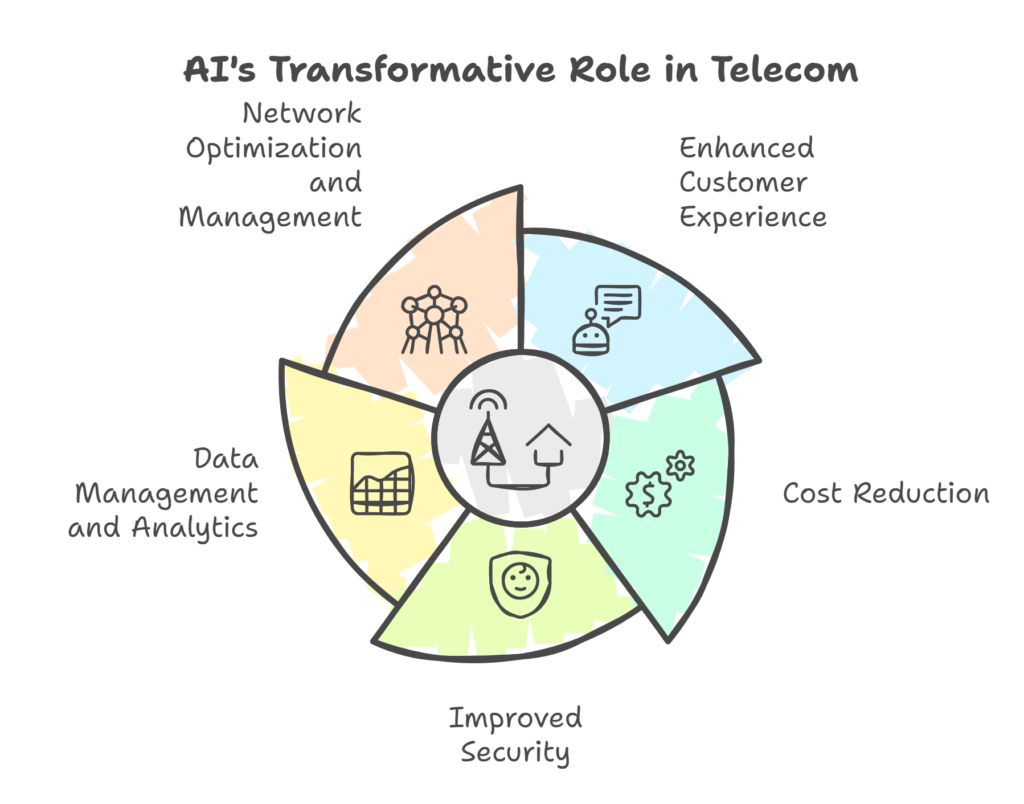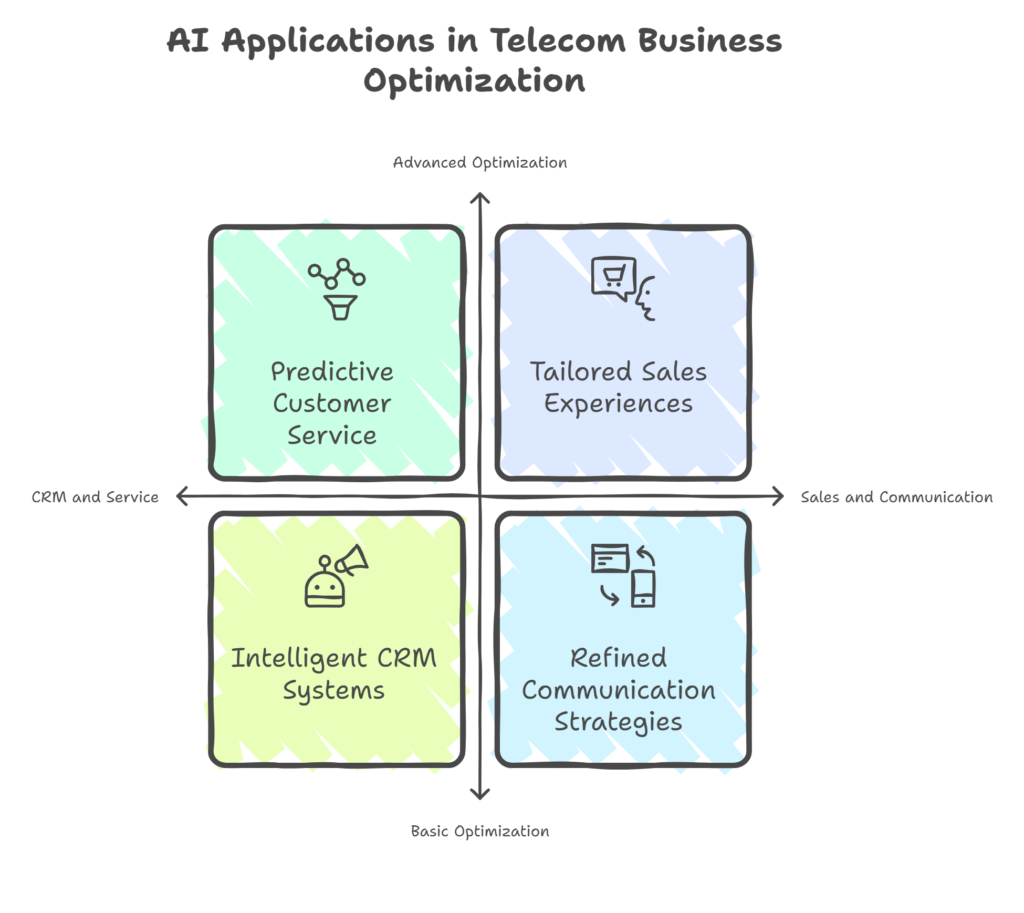TL;DR: The telecommunications industry is being transformed by the integration of artificial intelligence (AI), which enhances customer satisfaction, streamlines operations, reduces costs, and improves network performance. Key benefits include personalized customer support, predictive maintenance, enhanced security, and optimized data management. AI applications range from customer segmentation and automated service to intelligent network management and financial assessments for base station profitability. However, challenges such as data privacy, quality, integration, and workforce training persist. The future of telecom lies in leveraging AI to anticipate customer needs and drive innovation, ultimately reshaping the industry landscape.
The telecommunications industry is undergoing a major transformation with the integration of artificial intelligence (AI). This technological shift presents significant opportunities to enhance customer satisfaction, streamline operations, boost network performance, and facilitate data-driven decision-making. Companies leveraging AI can reduce costs, enhance efficiency, and remain competitive in a rapidly evolving market.
Key Benefits of AI in Telecom

- Enhanced Customer Experience: Automated services like chatbots provide personalized support, quickly addressing customer inquiries and predicting their needs to offer tailored solutions.
- Cost Reduction: Automating routine tasks and improving network efficiency significantly lowers operational costs while minimizing human errors and expediting resolution times.
- Improved Security: Advanced monitoring systems identify and prevent fraud and cyber threats in real time by analyzing unusual patterns in data.
- Data Management and Analytics: Large datasets can be processed to extract insights that inform operations, customer retention strategies, and new service offerings.
- Network Optimization and Management: Algorithms can predict and respond to network anomalies, improving performance and minimizing downtime, facilitating proactive maintenance and efficient traffic management.
Diverse Use Cases of AI in Telecom
In the telecommunications sector, AI is utilized in several impactful ways. It enhances customer segmentation by analyzing data to identify unique user groups, enabling targeted marketing and personalized offers. Automated chat support improves customer service by swiftly resolving inquiries, significantly reducing wait times. AI also facilitates predictive maintenance by analyzing equipment data to anticipate failures, allowing for optimized maintenance schedules and minimizing service disruptions. Continuous monitoring of network traffic bolsters network security, protecting sensitive customer information. Furthermore, AI aids in growth forecasting by analyzing historical and current data to inform network expansion and resource allocation decisions. Lastly, it enhances network optimization by analyzing traffic patterns, identifying bottlenecks, and reallocating resources effectively.
Applications in Network Operations
- Anomaly Detection: Systems can detect irregularities in operations, correlating issues and prioritizing them for better management.
- Performance Monitoring: Tools aid in optimizing performance, managing alarms, and resolving troubles automatically while predicting faults.
- Intelligent Network Management: Dynamic scheduling and resource optimization improve service prioritization and traffic handling.
- Predictive Maintenance: Anticipating equipment failures ensures timely interventions to minimize downtime.
Applications in Customer Service
- Call Center Automation: Automation allows for 24/7 self-service support, efficiently routing customer inquiries.
- Virtual Assistants: These tools rapidly address queries and provide personalized recommendations based on user patterns.
- Personalized Recommendations: Real-time adjustments to offers enhance targeted marketing efforts.
- Sentiment Analysis: Monitoring social media and customer feedback gauges sentiment about services.
- Voice Assistants: These systems interpret and respond to voice queries, allowing hands-free interaction for users.
Business Optimization Benefits
AI significantly enhances business optimization in the telecommunications industry through various applications. Intelligent CRM systems leverage advanced capabilities to identify promotional opportunities and predict customer churn, while predictive customer service utilizes data analysis to anticipate preferences and tailor solutions accordingly. Additionally, sales approaches are personalized based on customer insights, leading to tailored sales experiences. Communication strategies are also refined, with systems delivering content that adjusts to user behavior for more effective engagement. Finally, financial assessments of base stations help guide modifications to improve profitability, ensuring that resources are allocated efficiently.

AI Solutions for the Telecom Industry by XenonStack
XenonStack is a company that offers AI solutions for various industries, including the telecom industry. It provides a platform that can be used to build and manage AI systems, called NexaStack, along with other services like AI Managed Services. XenonStack’s AI solutions for the telecom industry include:
- Network operations monitoring and management.
- Predictive maintenance.
- Fraud mitigation and cybersecurity.
- Customer service and marketing virtual digital assistants and intelligent CRM systems.
- Customer Experience Management (CEM).
The Future of Telecom
The integration of advanced technologies in telecommunications is a transformative force that redefines customer service, enhances operational efficiency, and strengthens network management. As technology continues to evolve, its potential to reshape the telecom landscape offers exciting possibilities for both companies and customers. By gaining insights into customer interactions, telecom providers can anticipate needs and translate business strategies into actionable requirements. This proactive approach allows companies to meet customer demands, sometimes even before customers are aware of them.
Conclusion
The integration of advanced technology into telecommunications is a powerful force that enhances customer service, improves operational efficiency, and strengthens network management. As technology evolves, its potential to reshape the telecom landscape offers exciting opportunities for both companies and customers alike.



















